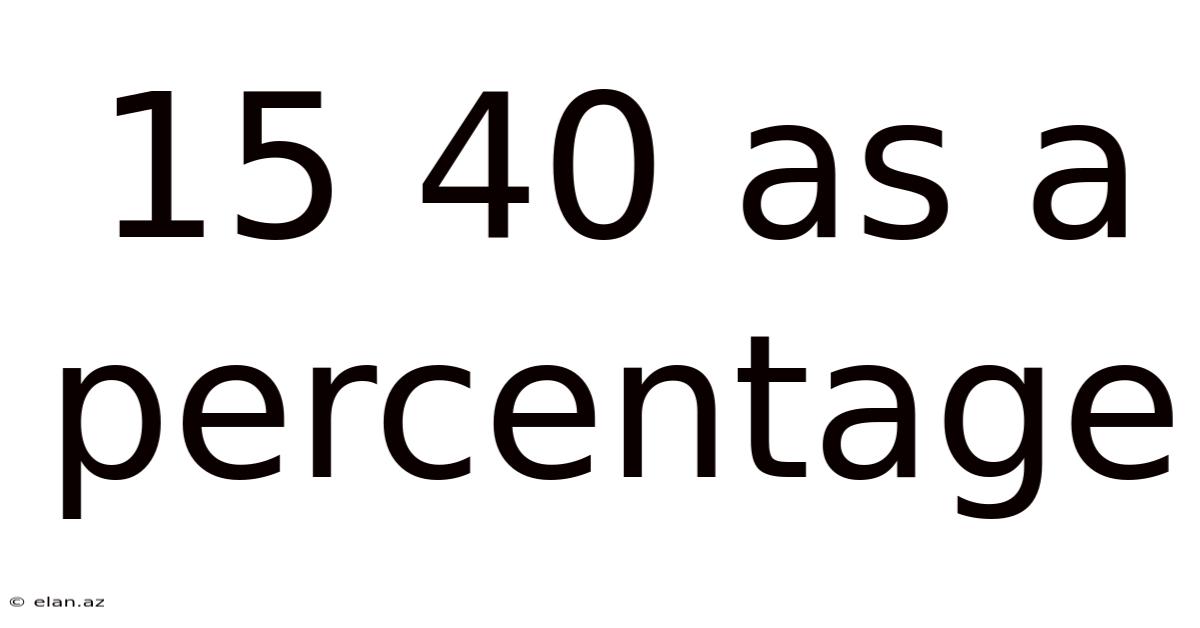15 40 As A Percentage
elan
Sep 17, 2025 · 4 min read

Table of Contents
15 out of 40 as a Percentage: A Comprehensive Guide
Understanding percentages is a fundamental skill in many aspects of life, from calculating grades to analyzing financial data. This article will comprehensively explore how to calculate 15 out of 40 as a percentage, providing not just the answer but also the underlying methodology, practical applications, and a deeper understanding of percentage calculations. We'll also delve into related concepts and frequently asked questions to ensure a complete grasp of the topic.
Introduction: Understanding Percentages
A percentage is a way of expressing a number as a fraction of 100. It represents a portion or proportion of a whole. The symbol "%" is used to denote a percentage. For example, 50% means 50 out of 100, or 50/100, which simplifies to 1/2. Understanding percentages allows us to compare different proportions easily and is crucial in various fields, including mathematics, statistics, finance, and everyday life.
Calculating 15 out of 40 as a Percentage: The Step-by-Step Approach
The core concept is to express the given ratio (15 out of 40) as a fraction and then convert that fraction into a percentage. Here's the step-by-step process:
-
Express as a Fraction: Write the given numbers as a fraction: 15/40. This fraction represents the portion (15) relative to the whole (40).
-
Simplify the Fraction (Optional): While not strictly necessary, simplifying the fraction can make the subsequent calculation easier. We can divide both the numerator (15) and the denominator (40) by their greatest common divisor, which is 5: 15/5 = 3 and 40/5 = 8. This simplifies the fraction to 3/8.
-
Convert the Fraction to a Decimal: To convert a fraction to a decimal, divide the numerator by the denominator: 3 ÷ 8 = 0.375
-
Convert the Decimal to a Percentage: Multiply the decimal by 100 and add the "%" symbol: 0.375 x 100 = 37.5%.
Therefore, 15 out of 40 is equal to 37.5%.
Alternative Calculation Method: Direct Percentage Calculation
You can also calculate the percentage directly using the formula:
(Part / Whole) * 100%
In this case:
(15 / 40) * 100% = 0.375 * 100% = 37.5%
This method bypasses the need to simplify the fraction and directly yields the percentage.
Practical Applications of Percentage Calculations
Understanding how to calculate percentages like 15 out of 40 has numerous practical applications:
-
Academic Performance: Calculating grades and scores in examinations. If a student answered 15 questions correctly out of 40, their score is 37.5%.
-
Business and Finance: Analyzing sales figures, profit margins, and market shares. For instance, if a company sold 15 units out of a total of 40 produced, their sales represent 37.5% of the total production.
-
Data Analysis: Representing data in a clear and concise manner using percentages. This is particularly useful in surveys, polls, and statistical reports.
-
Everyday Life: Calculating discounts, tips, and tax rates. A 37.5% discount on a purchase, for example, provides significant savings.
Beyond the Basics: Understanding Proportion and Ratio
The calculation of 15 out of 40 as a percentage is fundamentally about understanding proportion and ratio.
A ratio is a comparison of two quantities. In this case, the ratio is 15:40 (15 to 40). A proportion is a statement that two ratios are equal. We can express the proportion as:
15/40 = x/100
where 'x' represents the percentage. Solving for 'x' gives us the same result: x = 37.5.
Understanding Percentage Increase and Decrease
Percentages are also crucial when dealing with increases or decreases in quantities. Let’s imagine that a quantity initially at 40 units increased to 55 units. The percentage increase is calculated as follows:
((New Value - Old Value) / Old Value) * 100%
((55 - 40) / 40) * 100% = (15/40) * 100% = 37.5%
The quantity increased by 37.5%. Similarly, we can calculate percentage decrease.
Frequently Asked Questions (FAQs)
-
Q: What if I get a decimal percentage? *A: Decimal percentages are perfectly acceptable and often more precise. 37.5% is just as valid as 37.50%.
-
Q: Can I use a calculator for this calculation? *A: Absolutely! Calculators are helpful tools for performing these calculations quickly and accurately.
-
Q: Are there any other methods to calculate percentages? *A: Yes, there are several methods, including using proportions, cross-multiplication, and even using spreadsheet software like Microsoft Excel or Google Sheets. The method presented above is a straightforward and easily understandable approach.
-
Q: How do I round off a percentage? *A: The rounding method depends on the context. For academic scores, rounding to the nearest whole number (38%) might be sufficient. In financial calculations, more precision might be needed.
Conclusion: Mastering Percentage Calculations
Calculating 15 out of 40 as a percentage, which results in 37.5%, is a straightforward process that involves converting a ratio into a fraction, then a decimal, and finally a percentage. This skill is fundamental in various aspects of life, and understanding the underlying principles of ratios, proportions, and percentage increase/decrease further enhances one's ability to handle numerical data effectively. By understanding these concepts thoroughly, you’ll be well-equipped to tackle a wide range of percentage-related problems with confidence and accuracy. Remember, practice is key to mastering this essential mathematical skill. Try working through different examples to solidify your understanding. The more you practice, the easier it will become.
Latest Posts
Latest Posts
-
How Long Is 26 Inches
Sep 17, 2025
-
Chime Crossword Clue 4 Letters
Sep 17, 2025
-
Body Parts Beginning With S
Sep 17, 2025
-
Solving 2 Step Equations Worksheet
Sep 17, 2025
-
Simple Algebra Questions With Answers
Sep 17, 2025
Related Post
Thank you for visiting our website which covers about 15 40 As A Percentage . We hope the information provided has been useful to you. Feel free to contact us if you have any questions or need further assistance. See you next time and don't miss to bookmark.